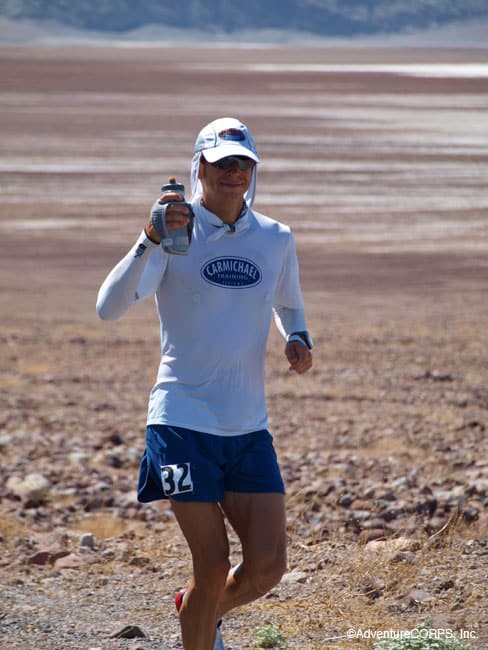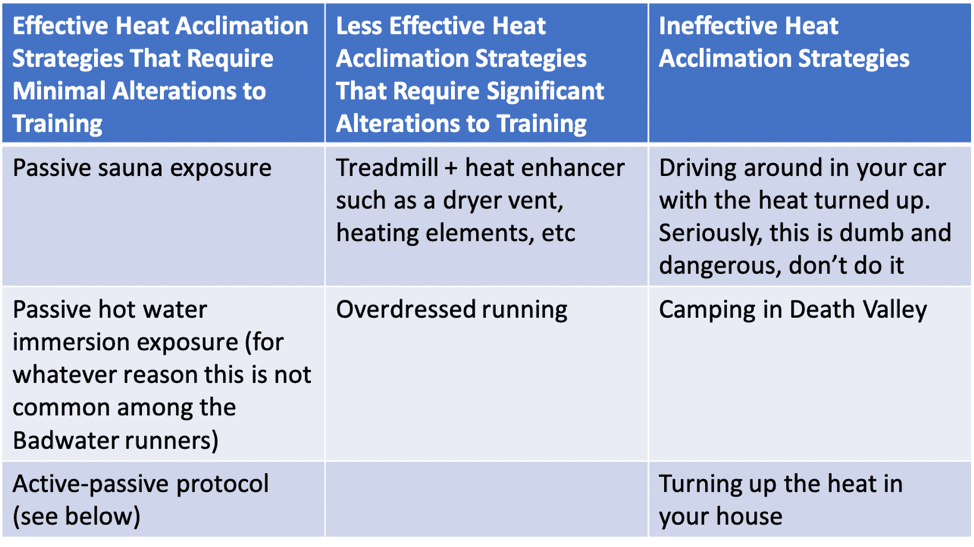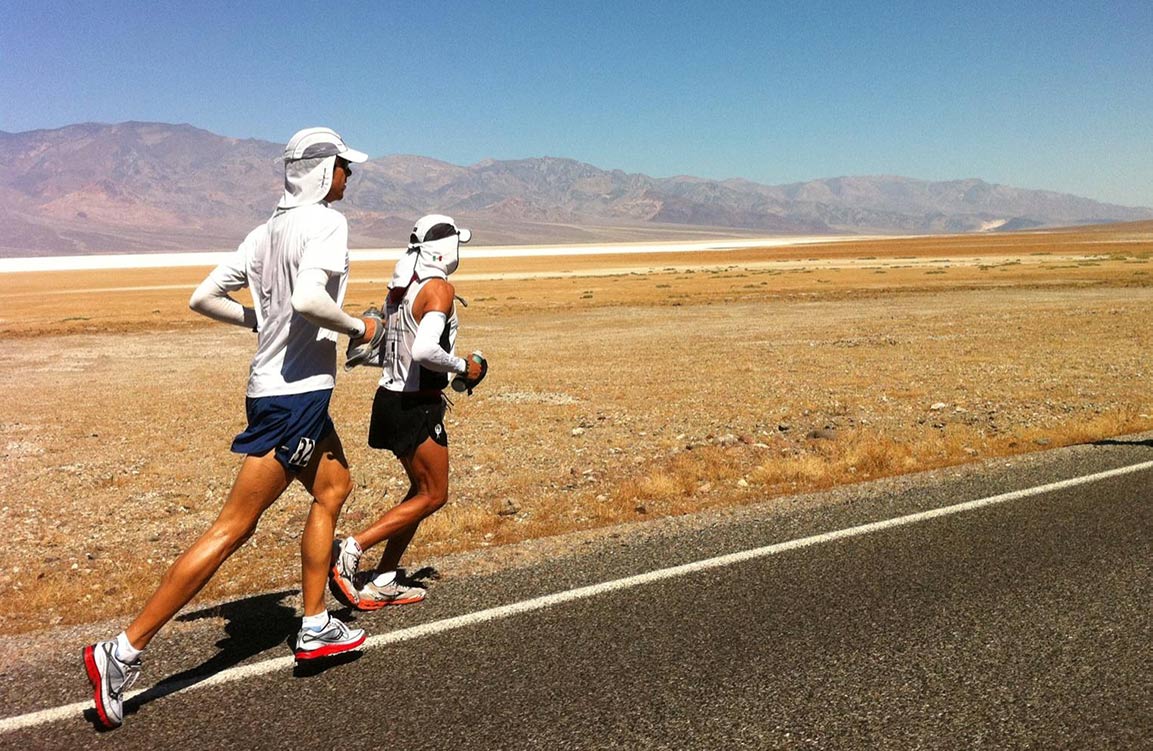By the time this newsletter hits your inbox, runners in the 2020 edition should have been testing themselves along the course of the Badwater 135, which many consider to be ‘the world’s toughest footrace’. Alas, in a very last-minute decision, organizers of the Badwater 135 cancelled this year’s edition, leaving this year’s field wondering what they could have accomplished with their fully formed fitness and heat acclimation strategies.

PHOTO ©ADVENTURECORPS, INC.
I have been fortunate enough to run and crew for the Badwater 135 a total of eight times, as well as prepare numerous runners for the event. All of these experiences have had an impression on me, and I am a better coach because of them. No other group of runners prepare quite as meticulously as the Badwater athletes do. The combination of the searing heat, mind numbing monotony of the road, the complexity of the application process and the exclusivity of getting an entry, the sheer expense of participating, and a relentless culture of improvement that has evolved over the years all combine to create what I observe to be the most prepared ultramarathon field on the planet. And the statistics bear this out. Badwater, despite the notoriously difficult conditions, has a finish rate of 85-90%. As a comparison, the Leadville Trail 100 hovers around a 50% finish rate for any given year, and the coveted Western States 100 has finish rates routinely between 70 and 80%. Make no mistake, the Badwater runners and their crews come fully prepared and bring it on race day.
Badwater is also one of the greatest hot environment sports performance proving grounds imageable. The searing heat will put your heat acclimation strategy to the test. Frequent access to your crew (your crew can leapfrog the runner in a support van) allows the runner to put cooling strategies and nutrition interventions in place without many logistical limitations. Being a crafty lot, Badwater runners have implemented an array of bizarre, sometimes effective and ultimately outlawed strategies in order to gain an advantage. Over the years I have seen everything from the use of refrigerated trucks to pacers on rollerblades with umbrellas (both of these strategies are now prohibited, by the way) to battle the heat. Still, the Badwater runners don’t always use the most efficacious strategies when it comes to heat acclimation and nutritional interventions. They tend to try to combat the challenges the course and environment will throw at them with contrived and combined strategies that at times are ineffective or even counterproductive. You might not ever have the urge to do the Badwater 135, but there are still some lessons we can all learn from the strategies this hearty group of ultrarunners use to battle the course and the heat, what actually works and how things go awry.
Heat Acclimation Strategies
Out of all the unique aspects in preparing for the Badwater 135, acclimating to the heat naturally gets the most attention. With temperatures that can be in excess of 120 degrees, runners rightfully approach this element of preparation with upmost importance. I first attended the Badwater 135 in 2006. When I arrived in Death Valley, I curiously took a straw poll of the participants to understand the heat acclimation strategies they used in training.

PHOTO ©ADVENTURECORPS, INC.
Over the years, either at the race of from afar, I have done the same straw polling and observed what the athletes were doing to prepare. I recently pulled my notes from these experiences and below is a short list of various protocols I’ve found, in no particular order:
- Running on a treadmill with a dryer vent blowing on your face. As a bonus, some runners would put portable heating elements round the treadmill for an added effect
- Running in the heat with a down jacket, pants and rain jacket
- Running on a treadmill in a greenhouse
- Running on a treadmill in the sauna. This normally involves cajoling the gym owner into some, shall we say, creative electrical engineering that may or may not pass a fire inspection
- If your gym owner was concerned about said electrical engineering, doing jumping jacks and core work in the sauna
- Driving around town with the heater turned up, perhaps with a down jacket
- Passive sauna exposure
- Camping in Death Valley in the weeks leading up to the event
- Turning up the heat in the house to > 90 degrees
- Some combination of some or all of the above with time frames that range from days to months
Although the complexity and duration of these protocols vary, they all can be catalogued into two broad categories: 1) passive acclimation/acclimatization strategies and 2) active acclimation/acclimatization strategies. Each have basic advantages and tradeoffs.
Passive strategies (strategies where you just sit there and let the environment do its job) allow for heat acclimation to occur with minimal interruption to training. They do not, however, allow you to ‘feel the heat’ while running, and many athletes feel the need to experience training in a hot environment before competing in one, simply to understand the sensation.
Active strategies (strategies that use a combination of exercises and environment) allow for heat acclimation to occur and for the athlete to feel the sensation of running in a hot environment. However, compared to Badwater, where the humidity is low and solar radiation is high, some of the contrived active strategies will be mismatched, particularly the overdressed ones that create a high humidity environment with little solar radiation. Additionally, active acclimation strategies involve some training compromise either by reducing the duration or intensity of the training session to accommodate for the increase in core temperature.
How Heat Acclimation Strategies Actually Work
Fundamentally, heat acclimation strategies work by inducing systemic and cellular responses to help your body cope with the heat. Systemically, your body responds (primarily) by increasing plasma volume and sweat rate in an effort to dissipate heat. Cellularly, your body upregulates heat shock proteins which act as cellular chaperones and managers for proteins that have been damaged by heat stress and other forms of degradation. Both systemic and cellular responses help athletes manage the heat in various ways, ultimately resulting in increased exercise capacity in the heat (and sometimes in temperate environments).
What has started to emerge in the research is that the extent of core temperature increase is critical to the success of the strategy. Heat up your body to a certain temperature and then hold that temperature for a certain amount of time and you get great results. Miss the mark on the temperature or duration and the physiological results are not as good. This critical core temperature, which appears to be in a very narrow range of 38-38.5 °C or 100.4-101.3 °F, is difficult to achieve and athletes will describe it as somewhere between ‘feeling hot’ to ‘too hot, dizzy and lightheaded’.
Through this lens, we can look at the aforementioned strategies from our (perhaps ill-fated) Badwater runners. Strategies that are capable of producing a core temperature of 38-38.5 °C will be markedly more effective than those that do not. Additionally, active acclimation strategies (strategies that involve running/cycling in the heat or overdressed) will most likely be hampered by compromising exercise intensity, as a high core temperature will limit the duration or intensity of running (how long can you run while being ‘dizzy and lightheaded’?).

The Best of Both Worlds
Many athletes now choose to use an ‘active-passive’ protocol, where they go out and do a normal run and then immediately jump into a sauna or hot water immersion bath. The initial run begins the process of increasing core temperate and the heat exposure from the bath or sauna finishes it off to achieve the critical temperature of 38-38.5 °C. In this way, training is not compromised and the sauna/hot water immersion bath session duration is reduced. If you really feel like you need to ‘feel the heat’ to experience the sensation of running in a particular environment, contrive the environment to try to match the temperature, solar intensity and humidity of your event as much as possible, and do so for the minimum number of sessions to do the trick. For the Badwater runners, a treadmill with a dryer vent blasting in your face a few times is a better option than running around in a down jacket for a month.
Hallucinations

THE VIEW OF RACERS RUNNING INTO THE EVENING, FROM WHITNEY PORTAL.
Ultrarunning has been known to produce good hallucinations. Sleep deprivation combined with physical exhaustion, bonking, and blurred vision is a ripe recipe for the mind to conjure up memories of distant past and teleport them into a fuzzy present. And Badwater hallucinations are the best, by far. While your trail ultrarunning compatriots will brag about stories of a stick that turned into a snake, a tree stump that looked like a bear or a rock that talked, the Badwater hallucinations take this altered reality to a whole other dimension. The runners at Badwater encounter a cast of characters ranging from the Michelin Man to old 49er miners. Even the infamous white line painted on the road gets in on the action by transforming into various beings of and out of this world. Hallucinations come complete with incomprehensible background stories (the Michelin Man is there to run for President), unintelligible plot lines (I was helping the 49er change a tire), and bizarre interactions that border between a Star Wars movie and a DMT trip.
There is zero training for this. So, I have no help for you here other than to say if you really want an out of this world experience, just go run Badwater.
Too Much Aid Can Be a Bad Thing
One of the differentiating features of the Badwater 135 compared to other ultramarathons is that you have copious access to your crew and supplies. Food, water, pacers, your medical kit and the all-important performance enhancing ice, are never more than several minutes away. And, this level of assistance can be intensive. I once paced an athlete from Furnace Creek to Stovepipe wells, just a 24.6-mile section of the race, and blew through over 60 liters (15.8 gallons) of ice water in the process of drinking and dousing. And while it might seem like a luxury to have your every ultrarunning need fulfilled at a moment’s notice, at times it can be a bad thing. Runners can take on too much fluid and too many calories, particularly in the beginning of the race, simply because they are there. And later they lean on their crews to bail them out of a situation when they could simply just put their head down and run.
Remember that when you are training, you are doing the vast majority of it by yourself. Almost any racing situation involves many times more support than you would receive during any training session. And Badwater is an extreme example of this. While ultrarunners should learn to leverage their crews, pacers and other support personnel, they should not rely on them to get the job done. You don’t need pacers or crew to get the job done (in most ultras). Do they help, yes. But, running is ultimately the responsibility of the runner.
Badwater will be back
Like many of the races that couldn’t happen this year, Badwater will ultimately be back. I look forward to returning in some capacity, as an athlete, coach or crew. I simultaneously learn and get a chuckle out of many of the strategies athletes use to prepare for the event. I love hearing stories of how many layers of clothing athletes put on for a simple training run and how Kermit the Frog ran alongside athletes in the middle of the night during the race. Soon enough, we will get to experience or hear about all of these again. Until then, we can learn for the next time.
References-
Gibson, Oliver R et al. “Heat alleviation strategies for athletic performance: A review and practitioner guidelines.” Temperature (Austin, Tex.) vol. 7,1 3-36. 12 Oct. 2019, doi:10.1080/23328940.2019.1666624








You must be logged in to post a comment.